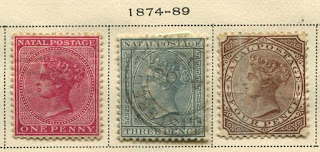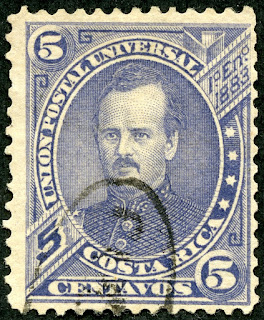I published a blog post back in 2011 about Costa Rica that was long on information, but short on stamp illustration.
Well, this post will rectify that. ;-)
Costa Rica is somewhat more straightforward for WW collectors than some other Central/South American countries. For one, the majority of stamps issued between 1863-1910 were engraved (not by Costa Rica - obviously it was contracted out). That cuts down on the "shenanigans" (Forgeries) that can occur with local printing methods such as lithography. However, any surcharges/overprints on issues (1881-82, 1911, 1903 Officials) are ripe for counterfeits.
The other occurrence is, in 1914, the government sold a large portion of formerly issued stamps (1901-1911 regular issues, 1903 postage due, 1901-03 Officials) as discount Remainders, marked by a thin parallel bar cancellations. These sell for much less than normal CV.
OK, let's take a look at issues of Costa Rica between 1863-1921.....
A Closer Look
8 Reales = 100 Centavos = 1 Peso
100 Centimos = 1 Colon (1900)
1863 Scott 1a 1/2r light blue "Coat of Arms"
The first release, in 1863, for Costa Rica, was a four denomination engraved issue.
The 1/2r denomination was printed with two plates. The second plate was printed in light blue, and shows little or no sky over the mountains (above- Scott 1a). The first plate (not shown) for the 1/2r denomination was printed in blue. The sky markings (horizontal lines) can be seen with the 4r green stamp illustrated above for the blog post header.
CV ranges from <$1 to $40+.
Although I don't have any examples, I should mention that, in 1881-82, three denominations (1/2r, 2r, 4r) from the above "Coat of Arms" issue were surcharged in red or black, creating seven major Scott numbers (Scott 7-15). These are valued in Scott only as "unused" - CV $3-$300). Counterfeits exist.
1883 Scott 18 5c blue violet
"Gen. Prospero Fernandez"
In 1883, a five stamp issue picturing
General Fernandez, the President of Costa Rica between 1882-85, was released. Note that this issue was engraved. Rather handsome stamp. Scott has a note that the 1863-1887 era have stamps that are classified as VF, even if they have perforations just clear of the design on one or more sides. Since most of the stamps of Costa Rica were engraved from 1863-1910, I'm not going to mention the printing method again (assume engraved), unless it is different.
1883 Scott 19 10c orange
Gen. Prospero Fernandez"
This is a 10c orange from the same 1883 issue that is socked on the nose (SON). Nice! CV for the issue is $1+-$10+ (used). I note that a 10c orange (unused) is CV $150! I also note that, so far, there is no change in CV for Costa Rica between my 2011 and my 2020 catalogue. Hardly a vigorous market. ;-)
1887 Scott 21 5c blue violet
"President Bernardo Soto Alfaro"
In 1887, a two stamp issue with Soto Alfaro pictured was released. He was president from 1885-1889, and assumed the presidency in 1885 when his father-in-law, President Fernandez, died. CV for the issue is <$1-$3.
Official 1887 Scott O23 10c orange
"President Bernardo Soto Alfaro"
Overprinted
The 1887 10c orange was also used as part of a six stamp 1887 Official issue. I should mention, as is common for many Central/South American countries, Official stamps were issued frequently. Costa Rica has, in Scott, 94 stamps released between 1883-1937.
1889 Scott 23 1c rose
On 1884 Scott AR1 - Black Overprint
In 1889, two postal-fiscal stamps of 1884 were overprinted "Correos" for postal use. Actually, the revenue stamps issued between 1884-1889 were authorized for postal use (postal-fiscal stamps) if a post office ran out of postal stamps. CV is $3.
1889 Issue Scott 25-31
"President Soto Alfaro"
In 1889, a ten stamp issue depicting President Alfaro was released. The higher denominations (Scott30-34) were usually used on telegrams. In fact, Scott 30-34 (50c-10p) are only valued by Scott "used" with a telegraph cancel. CV for the issue ranges from <$1 to $40+.
1892 Scott 37 & 37a 5c red lilac & 5c violet
"Arms of Costa Rica"
An "Arms of Costa Rica" issue of ten designs/ten stamps was issued in 1892. CV is <$1-$5.
Of note, notice (above) the wide color difference between major number Scott 37 & the minor 37a.
1892 Scott 44a 10p brown/yellow
"Arms of Costa Rica"
The 10 peso stamp can be found on colored paper pale buff and yellow (minor number). The 10c brown/yellow is only listed as "unused" @ CV $8.
1901 Scott 51 1col olive bister & black
"Birris Bridge"
In 1901, a ten stamp pictorial & portrait bi-color set was issued.
Birris Bridge - Engraved Close-up
Wow! - I love the detail on engraved stamps.
Birris River Railroad Bridge
The Railroad Bridge was built in 1890, and is now no longer in use.
1901 Scott 52 2col carmine rose & dark green
"Juan Rafael Mora"
Many of the 1902 show portraits - here
Juan Rafael Mora Porras, President of Costa Rica from 1849 to 1949. CV for the 1901 issue ranges from <$1 to $3+.
1903 Scott 56 6c olive green & black
In 1903 three additional stamps/portraits in new denominations were added. The 6c (above) has the highest CV @ $4.
1905 Scott 58b 1c on 20c lake & black "National Theater"
1901 Scott 49 Surcharged in Black
Diagonal Surcharge
In 1905, the 20c 1901 stamp was surcharged. One can find the surcharge horizontal (CV <$1), diagonal (this example (CV <$1)), or inverted (CV $10).
1907 Scott 63a 10c blue & black
Perf 11X14
The 1907 portrait bi-colored ten stamp issue of 1907 consists of two perf groups: The Perf 11 X 14 (2c, 4c, 20c, 50c, 1col, 2col) or Perf 14 (1c, 5c, 10c, 25c) group: These are major numbers. CV is <$1 to $100.
1907 Scott 68a 2col claret & green
Perf 14 - Remainder Cancel of 1914
The second Perf group consists of 11 X 14 (1c, 5c, 10c, 25c) or 14 (2c, 4c, 20c, 50c, 1col, 2col). These are minor numbers. CV is <$1 to $150.
However, if you recall from the introduction...
"The other occurrence is, in 1914, the government sold a large portion of formerly issued stamps (1901-1911 regular issues, 1903 postage due, 1901-03 Officials) as discount Remainders, marked by a thin parallel bar cancellations. These sell for much less than normal CV."
Therefore this 2col claret & green (Perf 14) CV is not $150, but $3 (Remainder cancel).
1910 Scott 75 25c deep violet
In 1910, a smaller format eight stamp portrait set was issued. The 25c deep violet (above) has the highest CV ($1.50 used), while the others are @ CV <$1.
1911 Scott 79 1c red brown & indigo
Stamp of 1907 Overprinted in Black
In 1911, seven stamps of 1901-07 were overprinted in red, black, blue or rose with "1911" or "Habilitado...1911". CV ranges from <$1 to $10+. Scott has a note that counterfeits exist.
Of interest, Juan Santamaria was a drummer boy (age 15) and a national hero. Click above to read the story.
1911 Scott 100 5c on 5c orange, Blue Surcharge
Telegraph Stamps Surcharged
Remainder Cancel of 1914
Also in 1911, Telegraph stamps were surcharged for postal use in rose, blue, or black. CV for the 15 stamps is <$1 to $80+. Of course, remainder cancels (as above) would generally reduce value. But in this case, the stamp already has a low CV of <$1. !!
Scott does have a complicated note about this issue, as there are counterfeits and special concerns.
1921 Scott 103 5c blue & black
"Coffee Plantation'
Lithographed
Out of the BlueThe only stamp that is not engraved with this post is the one above: a lithographed large format 1921 "Coffee Plantation" stamp. Note the relatively crude look. Actually, it looks like, for regular issues, there were none after 1912 until this June 17, 1921 stamp, which celebrates a century of coffee raising in Costa Rica.
Comments appreciated!



















































